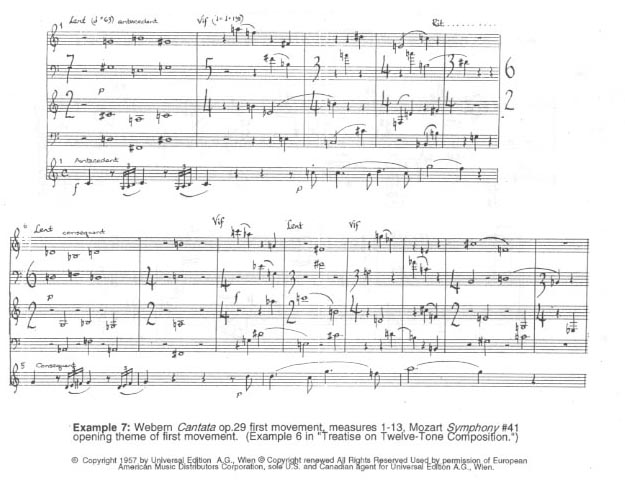Serialism is a musical movement from the 20th Century.
It is a very mathematical approach to composing, and as I explain it here you'll see what I mean.
What does it mean?
Serialism.
Serial.
Look at the word. It is well named, because Serialist music is music built from a "Series" of notes, and developed using a "Series" of techniques.
Mind blown yet?
What does it look like?
Looks a bit weird. Covered in numbers and letters that nobody quite knows what they are.

What does it sound like?
Serial music for a String Quartet
Descriptive terminology for the semi-uninitiated:
- Atonal
- Random
- Complex
Can you think of any other words you'd use to describe the sound, style and "feel" of this kind of music?
What's the story behind it? (optional - you don't really need to know this bit)
Wikipedia will point out that Debussy and Strauss and all those early 20th Century composers who liked to free themselves up with interesting scales, harmonies, structures etc "struggled against" what had become the norm... ie Rigid Structures, Scales and Modalities that defined something that we now know as Ordinary sounding music.
So imagine a room full of guys with moustaches in dinner jackets and bow-ties, with their facsimiles under their arms, having written the next big Tone Poem or Impressionist Symphony.
They're moaning about how rigid composition had become - and patting each other on the back saying how they've pushed the limits. They've added notes to chords and changes time signatures about, stretched the rules to be dead rebellious.
Then these younger guys walk in and introduce themselves as Arnold Schoenberg and Alban Berg. They want a wee look at what's been happening to revolutionise music and they have a wee chat about it.
So what happens is they go nuts. They dabble in something called "Free Atonality" and they just make random noises. It gets a bit of interest, does okay, and then guess what happens.
They apply a rigid structure to it.
Associated Concepts - AKA WHAT YOU NEED TO KNOW!
Serialist composition actually is a catch all term for some pretty specific "sciencey" approaches to making a piece of music.
But in SQA land, where you currently need to survive, it really only refers to Twelve-tone Composition.
In this particular process, there is a Tone Row.
Concept 1: Tone Row
The tone row is a set of 12 tones across the chromatic spectrum (basically, 12 completely different notes - there only are 12 if you think about it!)
It's the basis of the piece.
The composer starts by picking a Tone Row.

The top line of this "P1" is a Tone Row. Ignore all other letters, symbols etc.
If you were to play it - it'd sound atonal.
Next Concept: Retrograde
Retrograde means doing something backwards. If you retrace your steps, you're going in retrograde. If you rewind a video, it goes retrograde. If you play from right to left on the Prime Tone Row, you've played it Retrograde. (R8)
Next Concept: Inversion
Inverting something means making it turn upside down. If you do a handstand, you are performing an inversion.
If you play the Tone Row upside down, you're doing an "Inversion" of it (I3)
Next Concept: Retrograde Inversion
Hey... have you worked it out? It means to play the Tone Row both Upside Down (Inverted) and Backwards (Retrograde).
Easy. Here's one that I completely stole from wikipedia because it makes it so much easier than doing it myself. (IR8)
Suppose the prime form of the row is as follows:
Then the retrograde is the prime form in reverse order:
The inversion is the prime form with the intervals inverted (so that a rising minor third becomes a falling minor third, or equivalently, a rising major sixth):
And the retrograde inversion is the inverted row in retrograde:
Okay? So that's how many concepts
CONCEPTS HAUL: SERIALISM
Big one: Serialism
Associated acts:
- Tone Row
- Retrograde
- Inversion
- Retrograde Inversion
- Atonal
These are what you need to remember.
Here - this is a great webpage that gives an example of serialist music that has been analysed to point out each incarnation of the Tone Row.
And for your own listening fun... a playlist.





No comments:
Post a Comment
All comments will be moderated.